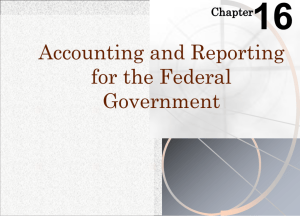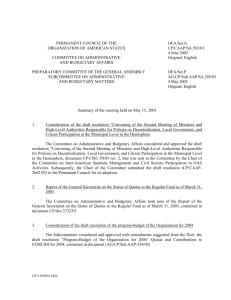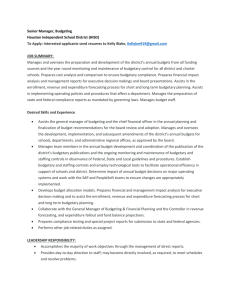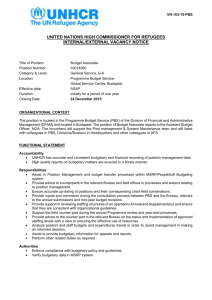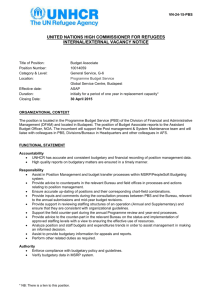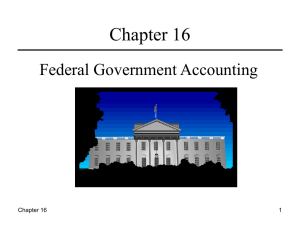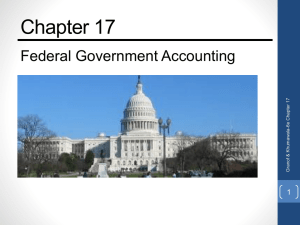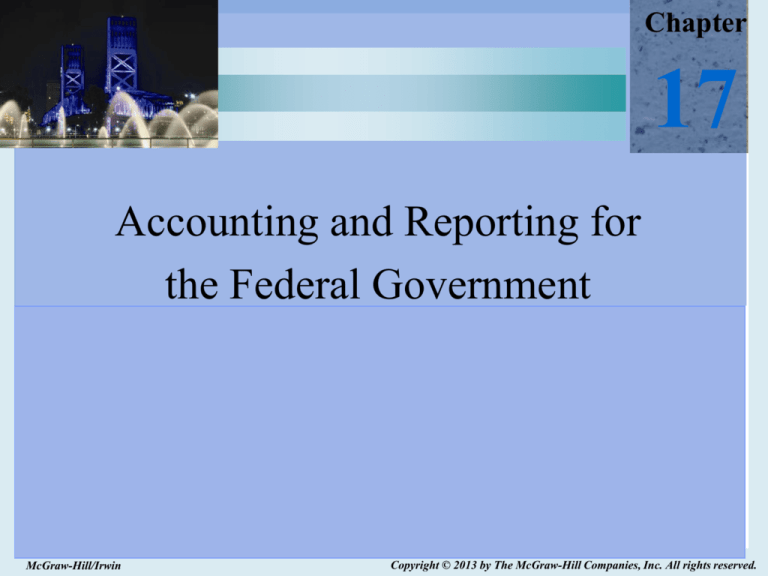
Chapter
17
Accounting and Reporting for
the Federal Government
McGraw-Hill/Irwin
Copyright © 2013 by The McGraw-Hill Companies, Inc. All rights reserved.
Learning Objectives
After studying Chapter 17, you should be able to:
Describe the financial management structure of the
federal government
Describe the process for establishing GAAP for the
federal government
Explain the concepts underlying federal accounting
and financial reporting
Describe government-wide financial reporting for the
federal government
17-2
Learning Objectives (Cont’d)
Describe federal agency performance and financial
reporting requirements
Contrast and compare budgetary accounting with
proprietary accounting
Record budgetary and proprietary journal entries and
prepare financial statements for federal agencies
Contrast and compare accounting for state and local
governments with federal agencies
17-3
Federal Government
Financial Management
The U.S. federal government is the largest
governmental entity in the world, comprised of:
Three branches of government (legislative,
executive, judicial)
Many offices (e.g., Office of Management and
Budget)
Many departments (e.g., Department of the Interior)
Many independent establishments and government
corporations (e.g., Postal Service, SEC, CIA)
17-4
Federal Government
Financial Management
Several acts of Congress affect federal government
financial management, for example:
Budget and Accounting Procedures Act of 1950
Federal Managers Fiscal and Integrity Act (FMFIA) of 1982
Chief Financial Officers Act (CFO) of 1990
Government Performance and Results Act (GPRA) of 1993
Government Management Reform Act (GMRA) of 1994
Federal Financial Management Improvement Act (FFMIA) of
1996
Reports Consolidation Act of 2000
Accountability of Tax Dollars Act (ATDA) of 2002
17-5
Federal Government
Financial Management Structure
Federal Financial Management Improvement Act
(FFMIA) of 1996
Requires federal agencies to comply with
established federal accounting and reporting
standards. Twenty-four specific agencies are
designated “Act” agencies by the GPRA of 1993
Each agency must follow the U.S. Government
Standard General Ledger at the transaction level
17-6
Financial Management Structure (Cont’d)
Federal statutes jointly assigned responsibility for
establishing and maintaining a sound financial
management structure within the federal government
to three “principals”:
Comptroller General of the United States
Secretary of the Treasury
Director of the Office of Management and Budget
17-7
Joint Financial Management Improvement
Program (JFMIP)
Three principals and the Office of Personnel Management set
up the Joint Financial Management Improvement Program
(JFMIP)
JFMIP’s purpose is to carry out responsibilities of establishing
and maintaining a sound federal financial management
structure
JFMIP’s work and the CFO Act of 1990 led to establishment of
the FASAB – see next slide
In 2004, the JFMIP realigned and delegated responsibilities to
the OMB’s Office of Federal Financial Management, the Office
of Personnel Management, and the Chief Financial Officer’s
Council
The JFMIP no longer meets as a stand-alone organization
17-8
FASAB
The Federal Accounting Standards Advisory Board
(FASAB) is the sole source of GAAP for federal
entities as identified by Standard No. 34
Funding for the FASAB comes from the sponsoring
organizations and the Congressional Budget Office
Currently, the FASAB is comprised of three federal
and six nonfederal members
The FASAB board submits proposed statements to
the sponsors, and if neither the Director of the OMB
nor the Comptroller General object, then the
statements become GAAP for federal entities
17-9
FASAB (Cont’d)
To date the FASAB has issued:
6 Statements of Federal Financial Accounting
Concepts (SFFAC)
41 Statements of Federal Financial Accounting
Standards (SFFAS)
Several reports, interpretations, technical
releases, bulletins, and staff implementation
guides
17-10
SFFAC No. 1 - Objectives
SFFAC No. 1 identifies four objectives of federal
financial reporting, based on the foundation of
accountability, which are to assist report users in
assessing
Budgetary integrity
Operating performance
Stewardship
Adequacy of systems and controls
17-11
SFFAC No. 2 - Entity and Display
Specifies the types of entities that should
provide financial reports
Establishes guidelines for defining each type of
reporting entity
Identifies the financial statements each type of
reporting entity should provide
Suggests types of information each statement
should convey
17-12
SFFAC No. 3 - MD&A
SFFAC No. 3 requires that a Management Discussion
and Analysis (MD&A) be included in the Performance
and Accountability Report (PAR)
Its purpose is to
Communicate managers’ insights
Increase understandability and usefulness of the
PAR
Provide accessible information about the entity and
its operations
17-13
SFFAC No. 4 - Target Audience
SFFAC No. 4 identifies five audiences for the
consolidated financial report of the U.S. government:
Primary audiences:
Citizens
Citizen intermediaries
Other audiences:
Congress
Federal executives
Program managers
17-14
SFFAC No. 5 - Elements and Recognition
SFFAC No. 5 provides the definitions of the basic
elements of accrual-based financial statements:
Assets
Liabilities
Net position
Revenues
Expenses
For an item to be recognized on the face of a
financial statement, it must meet the definition of
an element and be measurable
17-15
SFFAC No. 6 - Communication
Identifies three formats for communicating information
to users
Basic information – required for the information to be
presented in conformity with GAAP
Required supplementary information – information
FASAB says (RSI) must accompany the basic
information
Other accompanying information – information that
accompanies basic and RSI information but is not
required by FASAB
17-16
Funds used in Federal Accounting
Federal funds derived from general taxing and
revenue powers and from business operations
General fund (one for entire federal government)
Special funds (receipts earmarked for a specific
purpose)
Revolving funds (similar to internal service funds)
Trust funds held by the government as custodian
or trustee
Trust funds (both expendable and nonexpendable)
Deposit funds (similar to agency funds)
17-17
Federal Consolidated Financial Statements
The Government Performance and Results Act
requires 24 federal agencies to be audited and
comprehensive government-wide financial
statements be prepared
For every year the Government Accountability
Office has conducted audits of the federal
government’s consolidated financial statements, a
disclaimer of opinion has been issued
17-18
Federal Consolidated Financial Statements
(Cont’d)
For
FY 2010 three major issues resulted in a
disclaimer
Serious financial management problems at the
Department of Defense
Government’s inability to reconcile
intragovernmental activity and balances between
federal agencies
Ineffective process for preparing the
consolidated financial report
17-19
Required Financial Statements
The 2010 revision of OMB Circular A-136
requires that agencies prepare:
Annual performance report (APR)
Annual financial report (AFR)
Separate summary of performance and
financial information
OMB allows the APR and AFR to be presented in
a consolidated performance and accountability
report (PAR)
17-20
Sections of a Consolidated PAR
Management’s discussion and analysis
Performance reports – information on meeting the
agencies goals and objectives
Financial statements
Other accompanying information – a summary
table that includes information on the audit opinion
received and any internal control weaknesses, etc.
17-21
Required Financial Statements
Balance sheet (see Ill. 17-4)
Statement of net cost (see Ill. 17-5)
Statement of changes in net position (see Ill. 17-6)
Statement of budgetary resources (see Ill. 17-7)
Statement of custodial activity (see Ill. 17-8)
Statement of social insurance – for specified
programs (see Ill. 17-9)
Statement of changes in social insurance amounts
– for specified programs
17-22
Balance Sheet: Asset Classification
Assets
Entity
Assets
IntraGovernmental
Governmental
Nonentity
Assets
IntraGovernmental
Governmental
17-23
Balance Sheet: Asset Classification
Entity assets—are those the entity has authority to
use in its own operations
Nonentity assets—are held by the entity, but not
available for the entity to spend (e.g., federal income
taxes held by the IRS)
Intragovernmental assets and liabilities—
arise from transactions among federal entities
Governmental assets and liabilities—arise from
transactions between the federal government and
nonfederal entities
17-24
Balance Sheet: Asset Classification
Most federal entities do not have
their own cash
Entities draw against their “Fund Balance with
Treasury” account
Checks are sent by the Department of
Treasury to pay the entity’s obligations
17-25
Balance Sheet:
Property Plant and Equipment (PP&E)
General PP&E are used to provide general
government goods and services, military
weapon systems, and space exploration
equipment
Stewardship assets are of two types
Heritage assets have historical or natural
significance; cultural, artistic, or educational
significance; or architectural (e.g., the Lincoln
Memorial, Statute of Liberty, Yellowstone National
Park)
Stewardship land which is not used for operating
purposes (e.g., national parks)
17-26
Balance Sheet: Liabilities
Display funded liabilities (covered by budgetary
resources) and nonfunded liabilities (not covered
by budgetary resources) on the face of the
balance sheet
Recognize most liabilities on the accrual basis
Disclose in notes contingencies and estimated
cost to remedy deferred maintenance on PP&E
Treat capital lease obligations similar to those of
for-profit and state and local governments
17-27
Balance Sheet: Net Position
Components of net position are:
Unexpended appropriations – undelivered
orders and budget authority still remaining
Cumulative results of operations – net
difference between expenses/losses and
financing sources, including appropriations,
revenues, and gains, since the inception of the
entity
17-28
Statement of Net Cost
Shows the components of the net cost for the
reporting entity’s major programs (costs less
earned revenue)
Reports for the entity as a whole
The “bottom line” is termed Net Cost of
Operations
17-29
Statement of Changes of Net Position
Purpose is to communicate all changes in the
reporting entity’s net position:
Cumulative results of operations
Unexpended appropriations
Net costs of operations includes gross costs
less exchange (earned) revenues, as well as
Prior-period adjustments
Change in cumulative results of operations
Unexpended appropriations
17-30
Statement of Budgetary Resources
This statement presents the budgetary equation:
availability of
budgetary
resources*
=
status of
budgetary
resources **
* New budgetary authority + unobligated authority carried
over +/- budgetary adjustments
** Obligations incurred + budgetary authority still available
A third section shows the changes in budgetary
resources for the year
17-31
Statement of Custodial Activity
Required only by agencies (such as the IRS) that
collect nonexchange revenue for
The General Fund of the Treasury,
A trust fund, or
Recipient agencies
to report on an agency’s fiduciary responsibilities
as to the how much money was collected and how
monies were disbursed
17-32
Social Insurance Statements
The two social insurance statements are prepared by
a limited number of federal agencies
Statement of social insurance – recognizes a
liability when payments are due and payable
Statement of net changes in social insurance
amounts – reconciliation of beginning to ending
balances
17-33
Required Supplemental Information
Disclosures are also required about
Stewardship PP&E to highlight its long-term benefit
Deferred maintenance on PP&E
Stewardship investments - beneficial investments of
the government in such items as
Nonfederal physical property
Human capital
Research and development
17-34
Dual-Track Accounting System
Federal agencies are required to comply both
with budgetary accounting requirements and
accrual basis proprietary accounting requirements
Many transactions require an entry to record the
budgetary effect and a separate entry to record
the proprietary effect (i.e., the effect on net
position of the entity)
Illustration 17-10 presents a comparison of the
kinds of transactions and events that affect each
track’s accounting requirements
17-35
Relationship among Budgetary Accounts
Budgetary resources
Other appropriations
realized
Status of resources
Unapportioned authority
Apportionments
Allotments
Commitments
Undelivered orders
Expended authority
17-36
Illustrative Transactions for a
Hypothetical Federal Agency
The agency is notified its appropriation for the new
fiscal year is $1,000,000. It would make the
following general journal entries:
Budgetary:
Dr.
Cr.
Other Appropriations Realized
Unapportioned Authority
1,000,000
1,000,000
Proprietary:
Fund Balance with Treasury
Unexpended Appropriations
1,000,000
1,000,000
17-37
Illustrative Transactions (Cont’d)
OMB approved four equal quarterly apportionments
to the agency. The agency head, in turn, allotted
the full amount to subunits within the agency:
Budgetary:
Unapportioned Authority
Apportionments
Dr.
Cr.
1,000,000
1,000,000
Apportionments
Allotments
1,000,000
1,000,000
17-38
Illustrative Transactions (Cont’d)
Commitments were recorded in the amount of $700,000 for
goods and services expected to be ordered during the year
(note: these are not yet obligations). Purchase orders for
goods were issued in the amount of $650,000.
Budgetary:
Allotments
Commitments
Commitments
Undelivered Orders
Dr.
700,000
Cr.
700,000
650,000
650,000
17-39
Illustrative Transactions (Cont’d)
Goods were received at an actual cost of $640,000 for which
purchase orders had been issued for estimated amounts of
$620,000.
Budgetary:
Dr.
620,000
20,000
Undelivered Orders
Commitments
Expended Authority
Cr.
640,000
Proprietary:
Operating Materials & Supplies
Accounts Payable
Unexpended Appropriations
Appropriations Used
640,000
640,000
640,000
640,000
17-40
Illustrative Transactions (Cont’d)
Payrolls were paid in the amount of $100,000. The agency
does not record commitments for payroll.
Budgetary:
Dr.
100,000
Allotments
Expended Authority
Cr.
100,000
Proprietary:
Operating/Program Expenses
Disbursements in Transit
Unexpended Appropriations
Appropriations Used
100,000
100,000
100,000
100,000
17-41
Illustrative Transactions (Cont’d)
In the preceding proprietary JE, Disbursements in
Transit is a current liability account signifying the
agency has requested payment from the Treasury.
Assume, that payment has also been requested for
the Accounts Payable to vendors for goods received
(see previous transaction)
Proprietary:
Accounts Payable
Disbursements in Transit
Dr.
640,000
Cr.
640,000
17-42
Illustrative Transactions (Cont’d)
The agency received notification that all disbursements
in transit had been paid
Proprietary:
Disbursements in Transit
Fund Balance with Treasury
Dr.
740,000
Cr.
740,000
17-43
Concluding Comments
The focus of federal accounting is broad, including
information needed for management of resources
(proprietary track) as well as for compliance with fund
control requirements (budgetary track) – dual track
Legislation over the years charges the Comptroller
General, Secretary of Treasury, and Director of the
OMB to maintain financial management accounting
and reporting systems for federal agencies and the
federal government as a whole
FASAB statements are GAAP for federal agencies
END
17-44

